¶ Introduction
When an engine fails in flight in a turbojet, there are many things the pilots need to be aware of to fly the airplane safely and get it on the ground. This document will go over performance calculations and what to do during different phases of flight when losing an engine.
¶ Engine Failure Effects
On multiengine aircraft, when an engine fails, the aircraft will yaw and roll into the fail side.
This effect is caused because the operating engine is producing more thrust and energy which will change the center of lift and acceleration than the inoperative engine.
"Dead foot, dead engine" is a phrase that will quickly determine the failed engine -- meaning great rudder input will have to be provided in order to maintain directional control.
A light propeller or turboprop aircraft will perform better in single engine operations when the inoperative engine is feathered, which means the propeller is aligned with the relative wind and not windmilling (spinning freely). This will reduce drag on the inoperative engine and allow a better climb performance.
If the propeller is not feathered, there is a severe concern of safety in flight.
¶ Types of Engine Failures
In-flight engine failure -- in cruise flight, where once the engine failure is dealt with and coordination with ATC is performed, the pilot shall decide what is the nearest suitable airport.
ETOPS engine failure -- over the ocean where no alternate airports are around, the pilot will have to verify whether or not the plane is passed the Equal Time Point (ETP) and decide the fuel remaining to the ETOPS alternate.
Landing -- on final when an engine fails, a pilot should brief a single engine go-around in the event of a missed approach
¶ Engine Failure at V1
To review, V1 is the takeoff decision speed, meaning, if any engine failure occurs prior to reaching V1, the pilot should abort the takeoff.
Do not abort the takeoff roll after reaching V1
The worst case scenario is when you lose an engine right at V1 since this is the slowest speed on departure where if you lose an engine you will continue flying the plane and even rotate. Prior to rotation, stabilize the airplane's lateral movement with rudder and aileron correction to maintain runway centreline then apply a smooth rotation. Accelerate to V2, which is defined as your takeoff safety speed which the airplane can safely climb at on one engine.
Prior to departure during your preflight, you should have determined your acceleration height. This usually varies by airport and runway used for takeoff, but generally it is 1,100 ft AGL (above ground level). For example, if an airport has an airport elevation of 1,000ft MSL, your acceleration height would be around 2,100ft MSL (1,000ft + 1,100ft = 2,100ft).
Upon rotation, do not change the aircraft configuration with the exception of the gear. After positive rate, call "gear up" and level off at your acceleration height. After acceleration height, you can start retracting the flaps. Remember, FLY THE PLANE FIRST
When safe, advise ATC of an engine failure and let them know you will get back to them with your intentions. You might not necessarily be returning to your departure airport if the weather has fallen below approach minimums.
Once the flaps and gear are retracted, you should have enough speed to continue your climb. Leave your acceleration height and climb to whatever altitude ATC told you to maintain. At this point, a checklist can be run pertaining to the nature of the emergency or engine failure.
Observe the diagram below which shows a profile when an airplane encounters an engine failure at V1.
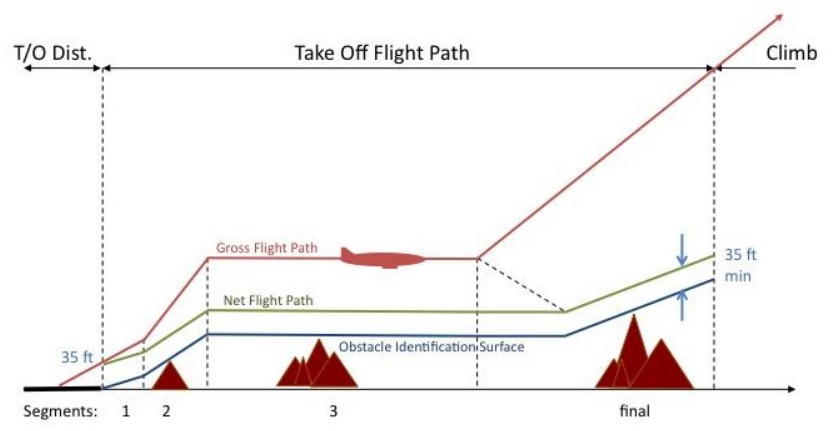
As shown in the diagram, segment 3 is where we level off at acceleration height and bug our MCP speed to "UP" so we can start retracting the flaps. By this time, we should be clear of all obstacles, which was one reason we flew at V2 in segments 1 and 2. When we finish segment 4, or the final segment, we will run our engine failure or fire checklists, after takeoff checklist, then plan for a diversion.
The autopilot will help you once you finish your final segment climb. Trim the plane and engage the autopilot so you can plan your diversion.
If the weather was below minimum, a takeoff alternate should be planned, which is an airport to go to if you cannot make it back to your departure airport and should be maximum one hour away on one engine in cruise flight.
See paragraph §2.4 Landing on one engine and single engine go arounds.
¶ Engine Failure In-Flight
An engine failure that occurs in flight when not over an ocean or ETOPS airspace (see section 2.3 for ETOPS engine failures) will involve some fuel planning. When an engine failure occurs, fly the airplane and maintain directional control and pitch attitude. Run the engine failure or fire checklist which will direct you to confirm which engine shut down, shutting down the hydraulics, electric, fuel, and pneumatic systems associated with that engine, turning the APU on to engage the APU generator, and if there is a fire, pulling and rotating the associated engine fire handle and switch to extinguish the fire. Once these tasks are complete, trim the plane and re-engage the autopilot. In the FMC, set L ENG OUT or R ENG OUT to set the proper thrust setting and set it.
A drift-down altitude is important to obtain in the event that we cannot maintain our current cruise altitude. This will be covered in the performance section of this document. Always advise ATC of your intentions and declare an emergency, when the airplane is under positive control.
As mentioned in the V1 engine failure procedures, at this time it is important to start considering alternate airports along your route. We need to find what is referred to as a "suitable airport", which is an airport that can handle our type of aircraft, approaches that will safely bring us in depending on the weather, emergency services, and maintenance facilities.
¶ Engine Failure during an ETOPS Flight
An engine failure during ETOPS will have the same procedures as section 2.2, with the exception of turning the APU on which should already be on for ETOPS (of course we will verify it is on and switch to the failed engine side generator) and planning a diversion.
To review, ETOPS, or Extended Operations, is when an aircraft is over 425nm (737) away from the nearest suitable airport, usually over the oceans.
There are not any airports in ETOPS airspace. Therefore, we need to refer to our dispatch release information regarding the ETP, or equal time point.

ETP 1EO means your ETP for one engine inoperative. If you have an engine failure prior to passing the ETP, in this case at N55.061W035.206 876nm away from CYYR, then you are returning back towards CYYR. If an engine failure occurs after the ETP, you will continue towards EINN. Here is what an engine failure over ETOPS airspace profile would look like:
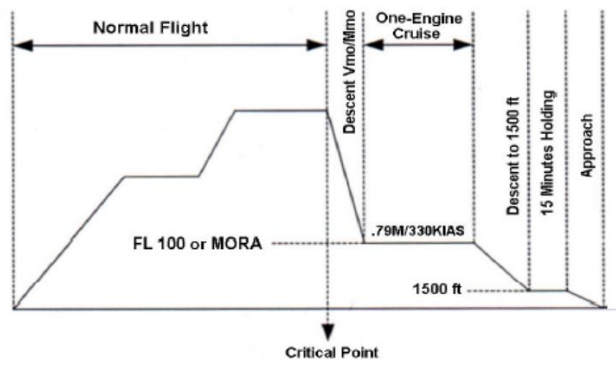
So when dealing with ETOPS engine failures, the majority of the procedures starts on the ground with preflight planning for fuel.
¶ Engine Failure on Landing and Single Engine Go Arounds
When you encounter an engine failure on final, it is not essential to verify immediately which engine has failed. Continue using both thrust levers to obtain your airspeed, however, ensure you change your VREF to optimum single engine landing speed. Landing should be made as normal.
Most aircraft manufacturers require continuing approach instead of going around immediately.
In the event of a missed approach, you will have to perform a go around on one engine. Manually increase the thrust levers to max continuous thrust. Apply rudder and aileron correction to maintain positive control and follow the flight director.
¶ Single Engine Performance
Multiengine aircraft are designed to operate on a single engine, however, there are a number of factors that will determine their performance. Factors such as temperature, pressure altitude, and weight of the aircraft affect the performance greatly.
¶ Propeller Drive Aircraft Performance
Propeller aircraft performance focuses primarily on how to achieve the most efficient climb and altitude.
Since they produce less power than most jet aircraft and are more subject to Vmc, single engine performance is extremely important to take into consideration when operating propeller aircraft.
VMC -- the minimum control speed of an aircraft at which directional control can no longer be maintained after the failure of one or more engines
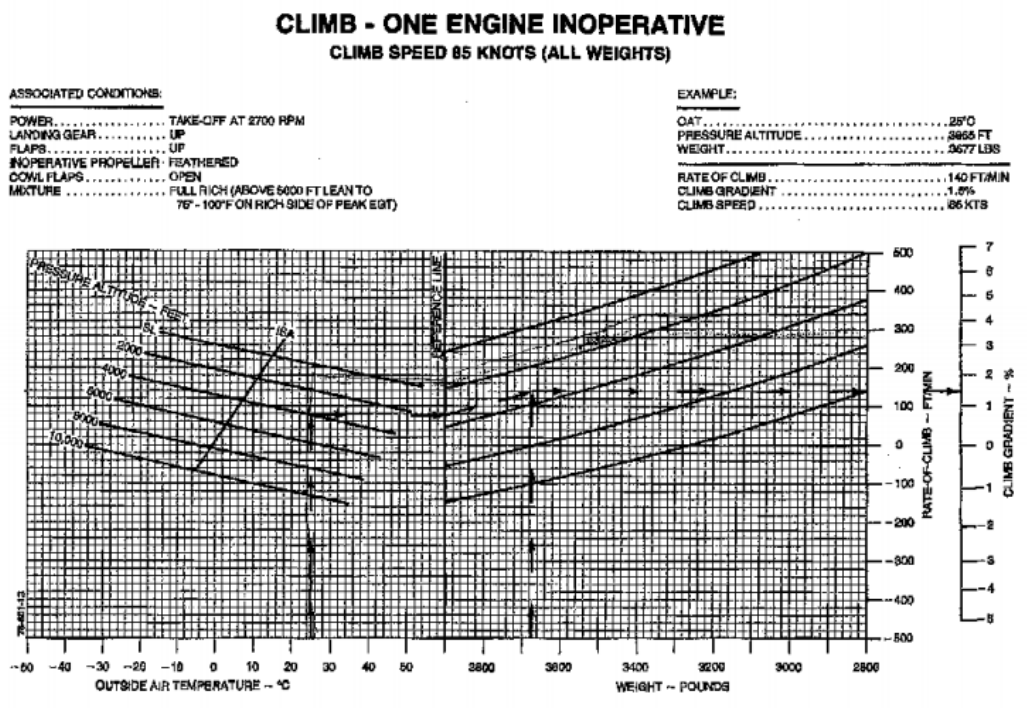
These types of charts may seem daunting at first, but if you follow the example dotted line drawn, it can help make some more sense of the information that can be gathered from it.
Look at the example on the top right of the chart and follow the dotted line drawn on the graph. This chart includes reference lines, meaning as soon as you reach one, you cut straight across to the next reference line and continue until you reach the far-right side of the chart. In the example given, we can expect a climb of 140 ft/min in the event of an engine failure right on takeoff, considering the conditions on the top left side of the chart have been met, such as feathering the inoperative propeller.

At higher altitudes in turboprops, drift down charts will assist in determining the most optimum altitude, fuel burn, and speed. Looking at the chart above, if the aircraft is at 20,000kg cruising at FL200, cross reference these two boxes. The bottom number, 14,900ft, is the optimum altitude for the aircraft to descend to and maintain. It will take 207 miles and 72 minutes at 132 knots burning 463kg of fuel.
¶ Jet Aircraft Performance
Jet aircraft fly at higher altitudes and produce more power than a turboprop. Therefore, factoring in maximum continuous thrust properly will ensure optimum speed and fuel burn. If an engine failure occurs in flight at cruise altitude, a drift down speed and level off altitude must be established.
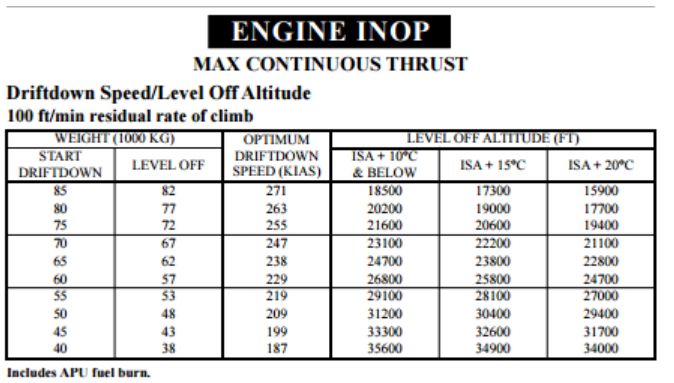
Looking at the chart on the left, we first need to determine our weight. In this example, let's use 55,000kg.
Find 55 on the Start Driftdown column. Using the data in the "55" line, we can determine our level off weight will be 53,000kg at a speed of 219 knots. To determine which altitude we level off at, we need to know the temperature outside. Let's say it is ISA +15C, our optimum level off altitude will be 28,100ft according to this chart.
Notice on this chart how the heavier the aircraft is and the warmer the air is, the level altitude will be lower and our speed will be higher.
This is because we will require a higher speed to maintain directional control due to the heavier weight and a lower altitude in warmer air since we experience a reduction in engine performance.
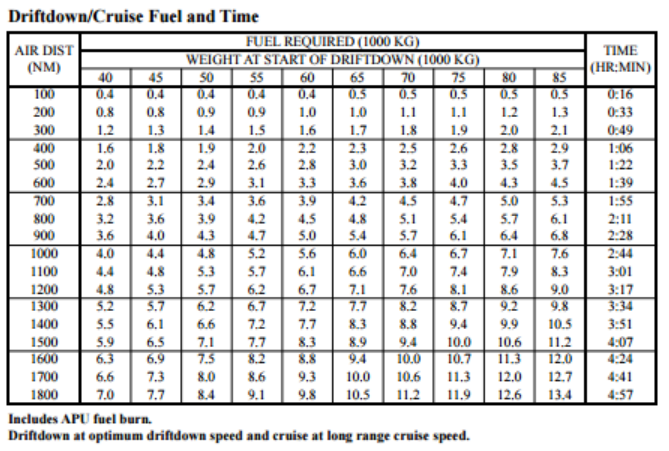
Another important determination is figuring out if we have enough fuel to make it to our alternate. There are two ways we can use this chart, depending on what is more critical, distance or fuel. If we have plenty of fuel, let's start with the distance side of the chart on the left. If the closest suitable airport is 500nm away, and we started our driftdown at 55,000kg, look at where 500 and 55 meet on the chart and we should see 2.6, which means it will take 2,600kg of fuel to fly 500 miles.
If fuel is critical and we can only burn no more than 1.5 until we reach reserve fuel, find 1.5 on the 55 column for weight and we will see we can only fly a maximum of 300nm in 49 minutes.
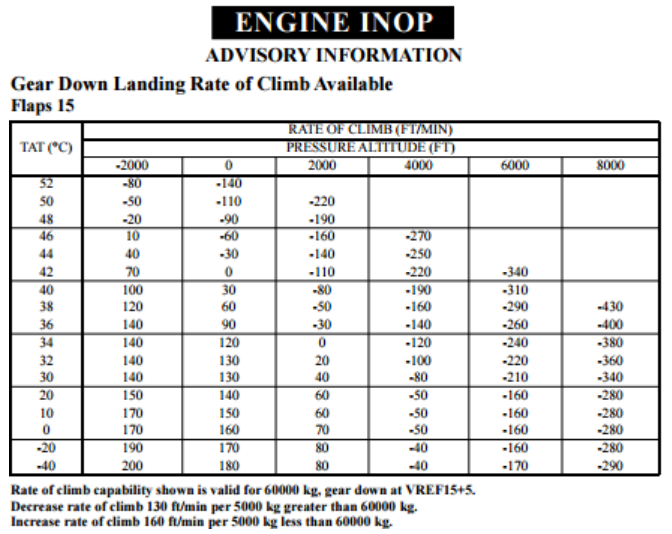
For landing, go around calculations for single engine performance are important to know. In this example, a landing made with flaps 15 with an OAT of 20 degrees at a sea level airport will result in a rate of climb of 140 feet per minute. On warmer days and higher airport elevations, it could possibly result in a negative rate of climb in which case the airport would be deemed not suitable.
A good pilot is always thinking about going around, even in single engine operations.
- None
- None
- VID 150259 - Creation
- VID 200696 - Wiki integration
- VID 496402 - Wiki.js integration